Are you a big fan of Japanese pastries and baked goods? If so, you’ll enjoy Anpan, a classic Japanese pastry with sweet red bean paste inside soft bread. This homemade recipe comes with my step-by-step tutorial to guide you through the bread-making process.
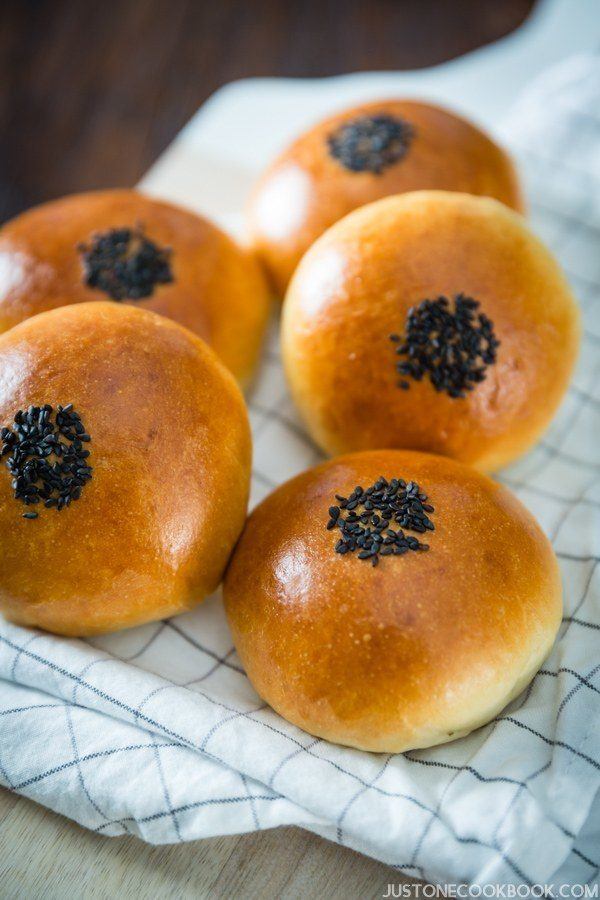
Anpan (あんパン), or sweet red bean bun, is my favorite Japanese bread growing up. It’s no secret that I absolutely love anko (red bean paste), and I love this Japanese bun that has a hint of sweetness, wrapped in a soft delicious bun.
My mom is a self-proclaimed bread connoisseur, and she loves exploring new bakeries and trying their bread in Japan. Unlike the US, there are many bakeries in most Japanese neighborhood and stations and many of them are outstanding. She would buy different types of bread from each store, and among them is always, my favorite anpan.
My favorite one is from Pompadour, one of my favorite bakeries in Japan. Yokohama-born Pompadour bakes European-style bread and their baguettes are incredibly delicious. Their anpan is quite unique because unlike Japanese style soft bread, their buns are French-style and it’s more crusty (but not quite as hard as baguette).
When my mom visited me in the U.S. in the past, she used to “smuggle” them in for me! She knew how much I would love this anpan.
This is just one of my nostalgic moments with the Japanese red bean bread, and I truly enjoyed testing this recipe, daydreaming about all the delicious anpan I enjoy back in Japan…
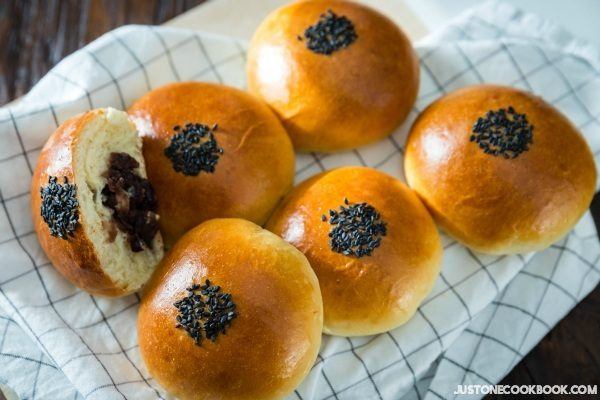
Invention & History of Anpan
So you may wonder, who came up with the idea to put anko (red bean paste) in a roll? It piqued my curiosity as well when I decided to test my anpan recipe, so I looked up its history.
Wiki explains well here, but basically it was first made in 1875 by a samurai named Mr. Kimura. He lost his job due to the dissolution of the samurai as a social class back in Meiji period. During that time, Japan was becoming more westernized and bakeries started to appear. His new job was a baker.

Soon after Mr. Kimura founded the now well-known bakery Kimuraya, he created a bread that was more to Japanese tastes. He replaced the traditional Japanese red bean mochi with western bread instead of mochi, and this bread stuffed with red bean paste was a brilliant one.
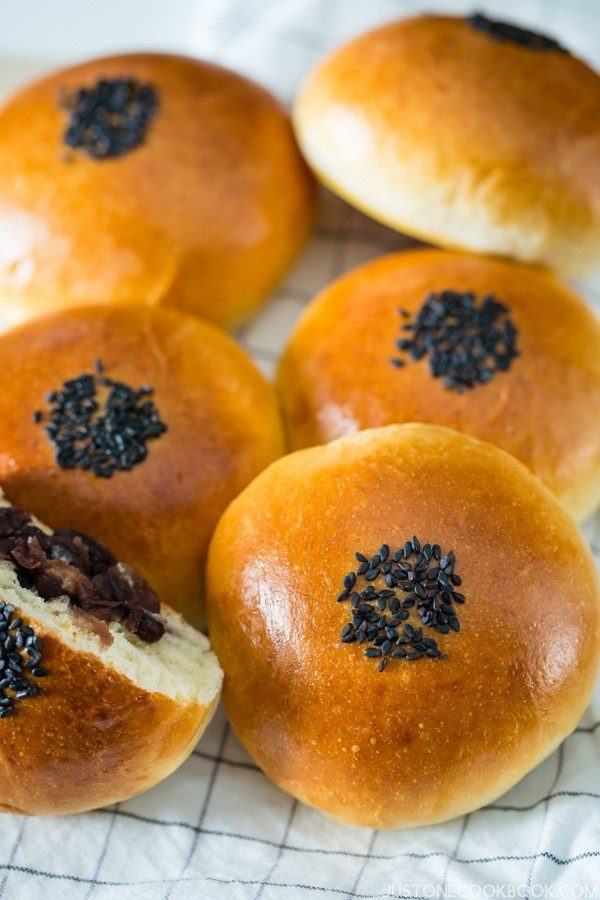
Making Anpan あんぱん
If you plan to make anko (red bean paste) from scratch, I recommend making anko ahead of time to save time on bread making day. I love making Pressure Cooker Anko recipe with my favorite Instant Pot (recipe here). Of course, to save time, you can always buy pre-made red bean paste from an Asian grocery store.
Anpan is one of the easiest Japanese bread to make at home, if you want to try making bread for the first time. Trying to make homemade bread could be intimidating, but the more you try, the easier it becomes. And this homemade anpan recipe is relatively easy, so I hope my video and step-by-step pictures will help you go through this journey.
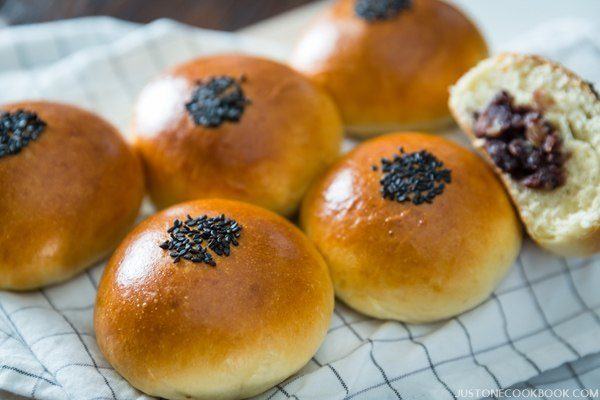
Wish to learn more about Japanese cooking? Sign up for our free newsletter to receive cooking tips & recipe updates! And stay in touch with me on Facebook, Pinterest, YouTube, and Instagram.
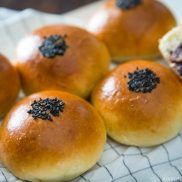
Anpan
Video
Ingredients
- 225 g bread flour (2 cups minus 2 Tbsp; plus more for dusting; weigh your flour or use the “fluff and sprinkle“ method and level it off)
- 3½ Tbsp cake flour (you can make Homemade Cake Flour)
- ¼ cup sugar
- 1 tsp Diamond Crystal kosher salt
- 1 tsp instant yeast (to use active dry yeast, see Notes)
- 1 large egg (50 g each w/o shell)
- 50 ml whole milk (3 Tbsp + 1 tsp; keep at 86ºF/30ºC; I highly recommend using whole milk instead of reduced-fat milk)
- 50 ml water (3 Tbsp + 1 tsp; keep at 86ºF/30ºC, see Notes)
- 2½ Tbsp unsalted butter (cut into small cubes)
For the Filling
- 10 oz sweet red bean paste (anko) (I use tsubuan, a coarse red bean paste, but you can use koshian, a fine paste; you can make my Pressure Cooker Anko or Stovetop Anko)
For the Toppings
- 1 large egg (50 g each w/o shell)
- 2 Tbsp water
- 2 tsp toasted black sesame seeds
Instructions
- Before You Start: Gather all the ingredients. I highly encourage you to weigh your ingredients using a kitchen scale for this recipe. Click on the “Metric“ button at the top of the recipe to convert the ingredient measurements to metric. If you‘re using a cup measurement, please follow the “fluff and sprinkle“ method: Fluff your flour with a spoon, sprinkle the flour into your measuring cup, and level it off. Otherwise, you may scoop more flour than you need.
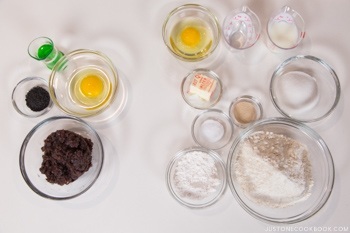
To Mix the Dough
- In a large bowl, combine 225 g bread flour (2 cups minus 2 Tbsp), 3½ Tbsp cake flour, ¼ cup sugar, 1 tsp Diamond Crystal kosher salt, and 1 tsp instant yeast.
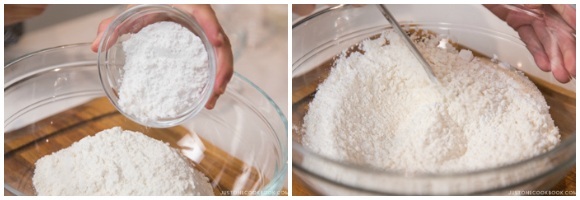
- Beat 1 large egg (50 g each w/o shell) in a small bowl and add to the bowl with the dry ingredients.
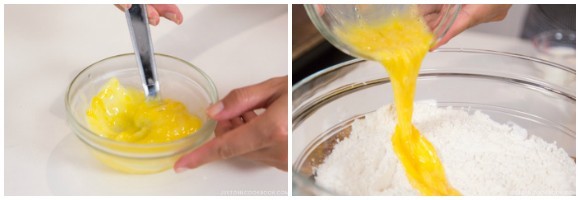
- Add 50 ml whole milk (3 Tbsp + 1 tsp) and 50 ml water (3 Tbsp + 1 tsp), both of which you‘ve kept at 86ºF (30ºC).
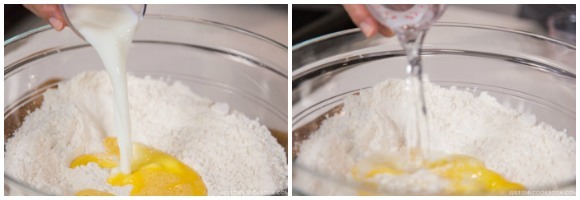
- Using your fingertips or a wooden spoon, gently mix the ingredients together until combined. In the beginning, the dough is very sticky and wet, but keep mixing until it forms a loose, sticky ball. Also, use the dough to pick up the flour on the sides of the mixing bowl. This step should take about 2 minutes.
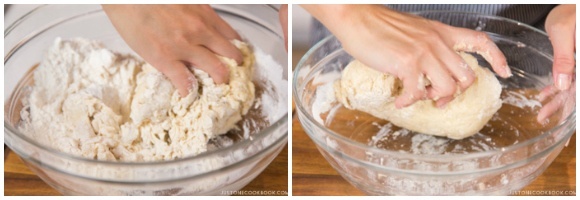
To Knead the Dough
- Dust a clean work surface with bread flour and transfer the dough from the bowl. Press the heels of your hands into the dough, pushing forward slightly. Fold the top half of the dough in half back toward you. Rock forward on the lower part of your palm to press it flat. Turn the dough slightly (to clockwise), fold it in half, and rock into it again with the lower part of your palm. This process is called “punching“ the dough and the goal is to lengthen and stretch the gluten strands. Repeat for 5 minutes or so. Tip: If the dough doesn‘t seem to be losing its stickiness, sprinkle more flour over the top and work it into the dough. You can lightly dust your hands with flour to keep the dough from sticking too much.
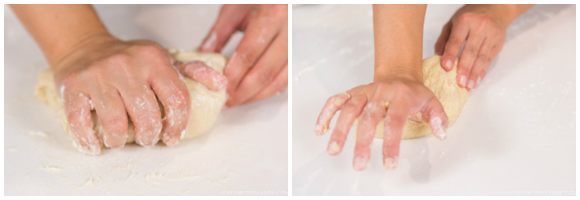
- After “punching” for 5 minutes, the dough will become more elastic. Press and stretch the dough until it measures 10 inches (25 cm). Then, put small cubes of 2½ Tbsp unsalted butter on top of the dough. Roll up the dough, tucking in the butter, and then continue the kneading process.
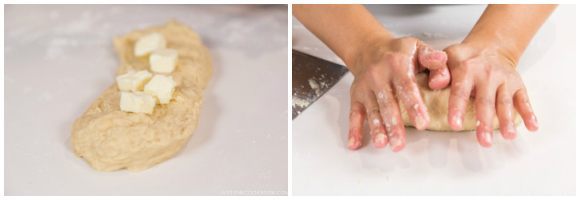
- Your hands, dough, and the working surface will get oily and messy in the beginning. I recommend using a metal/silicone dough scraper to collect the dough stuck on the working surface.
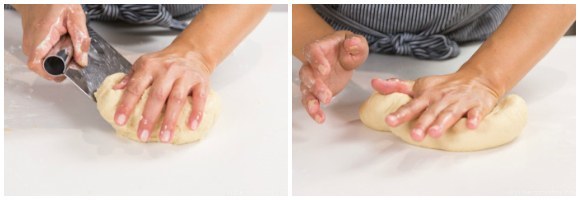
- As you knead, the dough will absorb the butter and it will eventually become smoother and easier to work with.
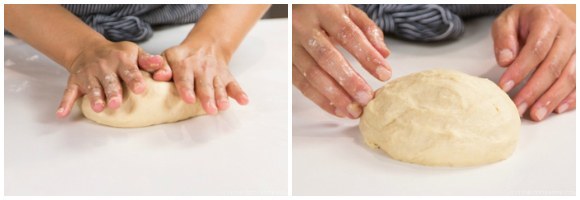
- When the dough becomes smooth, start banging the dough onto the counter and fold it over away from you. This helps develop the gluten (elasticity). Bang the dough, turn it 90 degrees, and “punch” it, using the lower part of your palm. Continue this process for 10 minutes or until the dough is smooth, supple, and silky. Tip: Don’t let go of the dough when you are banging onto the counter. Don’t let it rest for too long between turns.
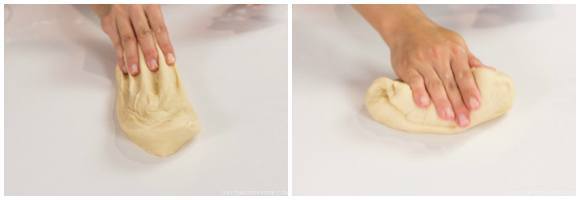
- Now, it’s time for the windowpane test. Either pull on a part of the dough or tear off a small piece. Hold the dough in both hands and gently pull it into a square with your fingers. It should be very elastic, smooth, and shiny. If it‘s strong enough to stretch to a super-thin membrane without tearing and light can pass through the center, your dough passes the test. If it doesn’t stretch or it tears too easily, knead it again for another 2 minutes and test again.
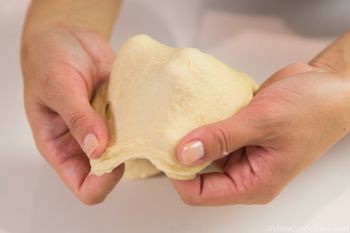
The First Rise (Bulk Fermentation)
- Shape the dough into a ball by pulling all sides of the ball to the bottom and pinching them together.
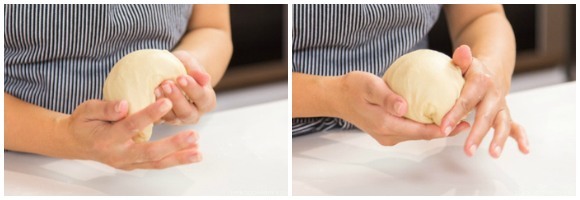
- Place the dough in a bowl, seam side down, and cover with plastic wrap. Let the dough rise in a warm place until it has doubled in size, about 1–2 hours. I use the Proof setting (100ºF/38ºC) in my oven.
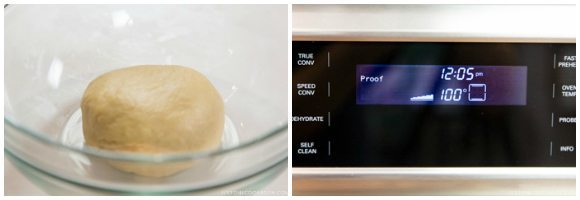
- Once the dough has doubled in size, use the finger test. Dust your index finger (or the top of the dough) with flour and use your index finger to poke the middle of the dough. If the hole does not close up, it’s ready for the next step. If the dough closes up immediately, proof the dough a little longer and test again.
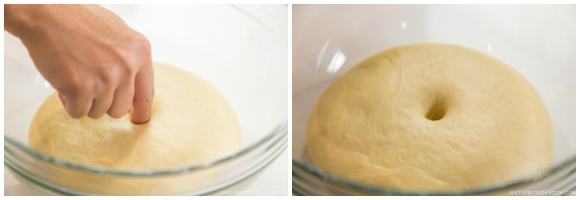
To Divide the Dough
- Press the dough with your hands to release the gas and deflate the dough.
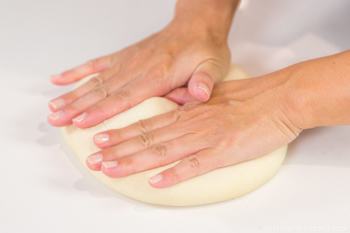
- Fold both sides of the dough toward the center.
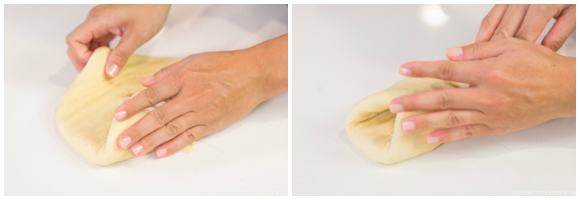
- Then fold it in thirds toward the middle. Flip, keeping the seam side on the bottom.
- Shape the dough into a ball, rotating (clockwise) with both hands while the seam line is touching the work surface.
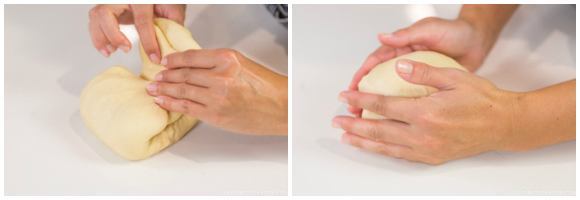
- Using a dough scraper, cut the dough into 8 equal pieces. If you need to adjust the size of dough, pinch off the center of the big dough and add to the center of the small dough and knead to combine well.
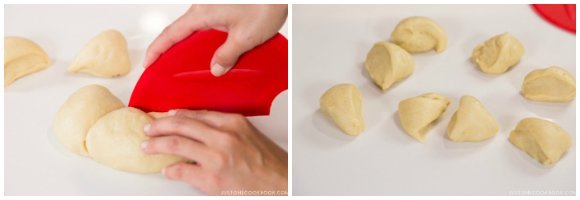
- Shape each dough piece into a nice round ball, pulling from all sides and tuck into the bottom. Place the dough on your left (right) palm, and rotate it with your right (left) hand, keeping the seam side on the bottom.
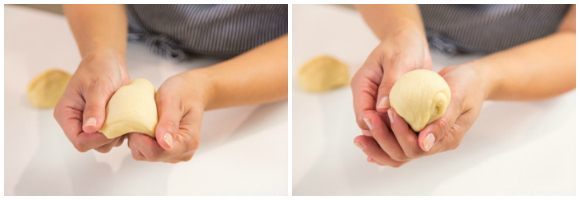
- Put the dough on a baking sheet lined with parchment paper or a silicone baking mat. Cover the dough with plastic wrap to prevent it from drying. Rest the dough for 15 minutes at room temperature.
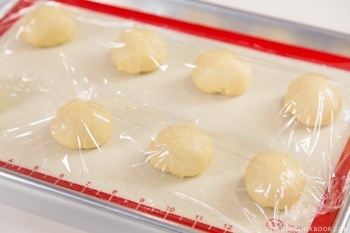
To Form the Anpan
- After resting, flatten the dough balls with your hand, fold in thirds twice (just like you did earlier), and shape into balls again.
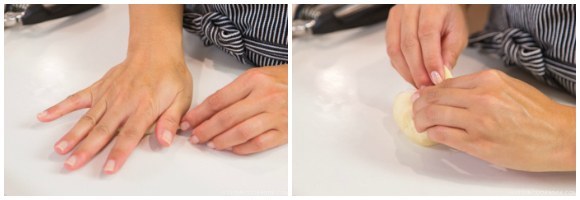
- For each dough ball, press it so it stretches to a 3 inch (8 cm) diameter. From the 10 oz sweet red bean paste (anko), scoop 35 g and place in the middle of the dough. Then pull all sides of the dough around and wrap the red bean paste tightly to seal.
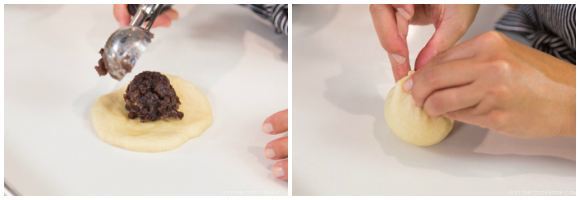
- Pinch the seam very well and put the seam on the bottom. Place the dough on your left (right) palm, and rotate it with your right (left) hand a few times, keeping the seam side on the bottom. Put the dough back into the baking sheet, seam side on the bottom. Continue forming the rest of the anpan.
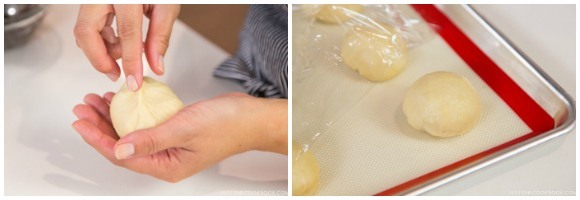
The Final Rise (Proofing) and Oven Preheat
- Cover the dough with plastic wrap to prevent it from drying. Let the dough rise in a warm place until the dough has doubled in size, about 30 minutes (I used the Proof setting (100ºF/38ºC) in my oven). When the dough has risen halfway, preheat the oven to 400ºF (200ºC). For a convection oven, reduce cooking temperature by 25ºF (15ºC). Note: If you are using the oven to proof, you have to transfer the dough to a warmer place so you can preheat the oven.
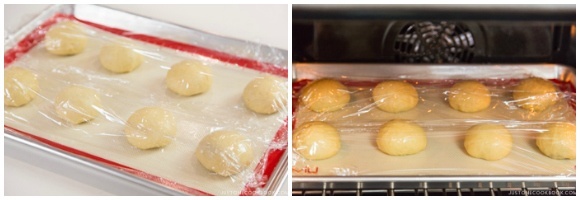
- In a small bowl, add 1 large egg (50 g each w/o shell) and 2 Tbsp water and whisk very well. Using a pastry brush, brush all sides of the dough with an egg wash.

- Put 2 tsp toasted black sesame seeds in a small bowl. Dip the flat round side of a rolling pin (about ¾ inch (1.9 cm) diameter) first in the egg wash, then into the black sesame seeds, and finally into the top of the dough to stamp it with the seeds. Alternatively, you can simply sprinkle the black sesame seeds on top.

To Bake
- Bake at 400ºF (200ºC) for 13–15 minutes. Toward the end of baking if you see the bread rolls are not browning equally, rotate the baking sheet once so that the anpan brown evenly.
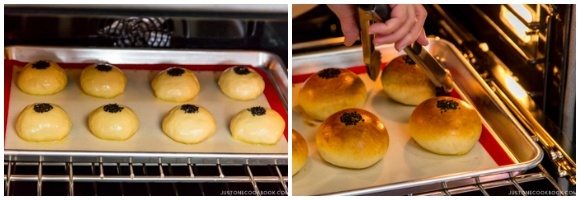
- Once the bread is baked, transfer to a wire rack and let it cool. Serve warm or at room temperature immediately. Enjoy!
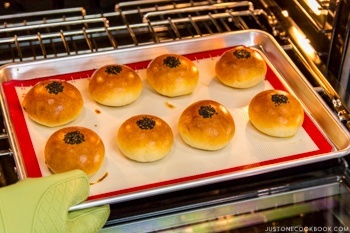
To Store
- You can keep the bread in an airtight container after it’s been cooled and store at a cool place for 2–3 days or in the freezer for a month.
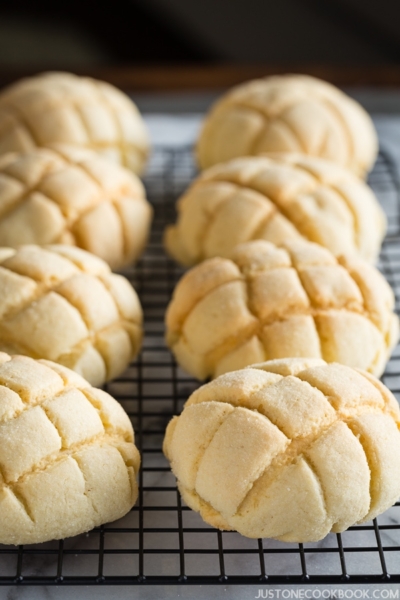
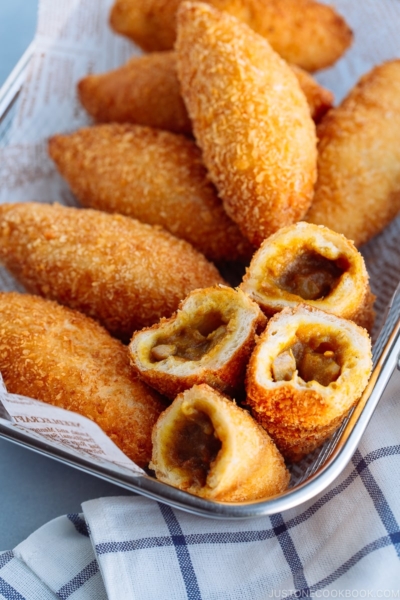
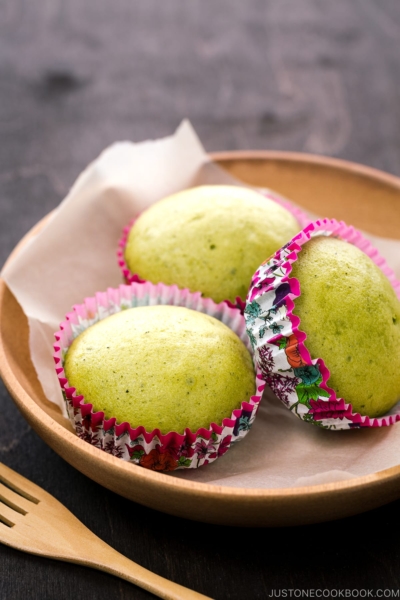
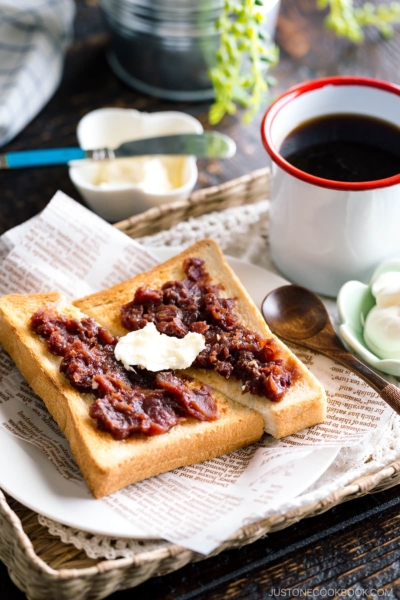
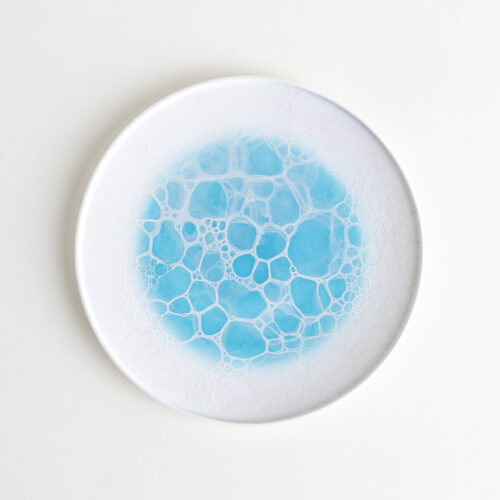
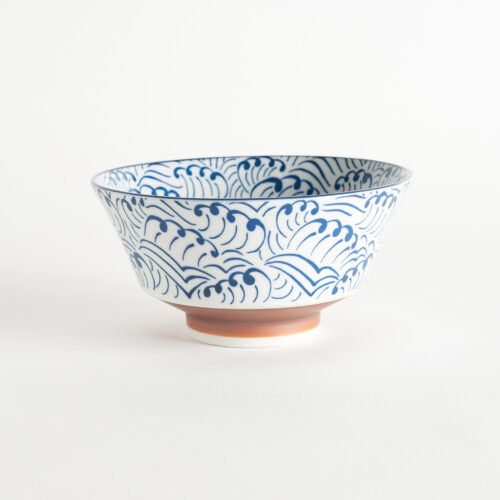
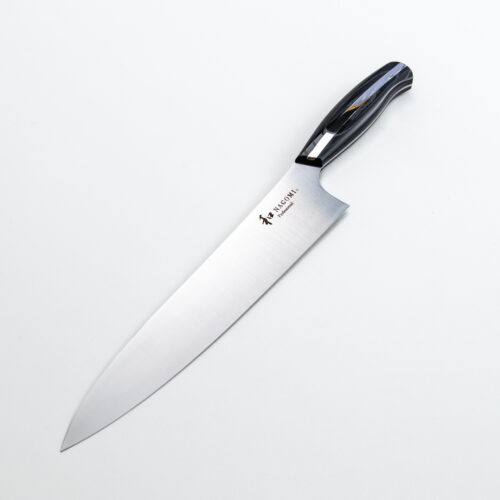
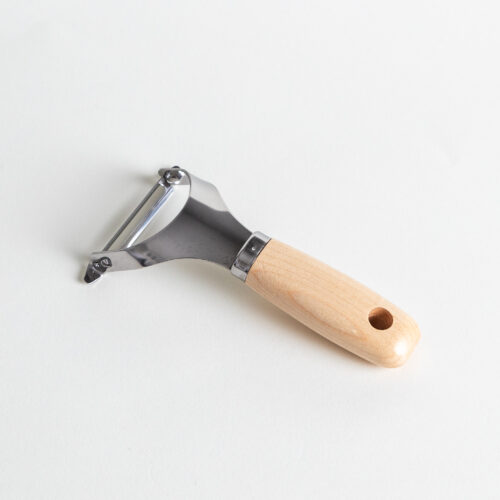

Hi! I’ve baked this recipe before and it’s fantastic! But I’m trying to cut my sugar intake. Has anybody tried removing the sugar from the recipe?
Hi, Jaz! Thank you for trying Nami’s recipe. We’re glad to hear you enjoyed it.
You can cut the amount of sugar in this recipe by half. However, without the sugar, the bread texture would be different, not as soft as in this recipe, and the Anpan would not be as brown.
We hope this helps!
👍 👍 👍 👍 👍
Looks fantastic!🤩 Lynn, thank you for sharing your Anpan photo with us!
OMG this recipe is super! I followed all steps, except for baking temp (my home oven is kind of too hot, so reduce to 375F. All buns looked like store bought! Super yummy! All my family members gave a thumb up! Thank you very much for sharing the recipe & all details on each step!
Hello Lynn! We are so happy to hear you enjoyed Nami’s recipe!
Thank you for reading Nami’s post and for your kind feedback.
Happy Baking!
it was so good! i like sweet things and ive been trying to cut down so this a great way for me to get what i want without eating to many unhealthy sweets
Hi aisha! We are so happy to hear you enjoyed Nami’s recipe!
Thank you so much for trying her recipe and sharing the Anpan photo with us! It looks so delicious! 😊
Hi Nami,
Could I use a stand mixer to make the dough?
Thank you.
Hello, Tina! Thank you so much for taking the time to read Nami’s post!
Yes, you can use a stand mixer. For reference, here’s Nami’s melon pan recipe with a stand mixer. We hope you find this information useful!
https://www.justonecookbook.com/melon-pan/
Thanks for the detailed recipe! It’s my first time making bread and it turned out very well. I appreciate the photos and the video to go with the written instructions.
I do have a question about the recipe though. Is there a way to make the bread more fluffy/soft? From what I’ve read, there are a lot of factors that could affect the softness but I wanted to double check in case there is something in the recipe that I could modify?
Hi Eve, Thank you so much for trying Nami’s recipe!
We are so happy to hear you enjoyed your first time making bread. This takes a lot of time to make nice bread, but isn’t it worth it?
Some people use milk powder or add more milk to make the bread more fluffy or soft; however, we did not test it, so we are unsure how much of an increase will achieve your desired texture.
Please let us know how it goes if you give it a try!
Thanks for the recipe. Made it using my Air fryer
Hi SK! Wow!🤩 Fantastic!
Thank you for trying Nami’s recipe and sharing your baking experience and beautiful photo!
Hello. Will this recipe come out if I replace the egg with a flax egg? I want to make this but I am vegan. Thank you!
Hi Akiko! Thank you very much for reading Nami’s post and trying her recipe!
We have never used a flax egg for this recipe and are unsure if it works.🤔 If you try it, let us know how it goes!
These were amazing! 😍 thank you so much for such a thorough recipe with easy to follow pictures and instructions. I purchased red bean paste to start with, before attempting to make my own, and this was the perfect way to try it! They turned out great! I did end up using all purpose flour because it’s all I had on hand, but I’m very anxious to get to the store this weekend and make them again properly with bread flour 💕 Well done!
Hi Amanda! WOW! The Anpan is so beautiful!😍
We’re so glad to hear that you found Nami’s tutorial helpful.
Thank you very much for trying Nami’s recipe and sharing your Anpan photo!
I just made these and they are soooo delicious!! I have never made any kind of bread before but the detailed recipe with lots of pictures was really helpful and it turned out so well. I love anpan and I have been craving it so it was really fun and satisfying to try making it. Next I want to try your karepan recipe!
Hi Melanie! Aww. We are so happy to hear Nami’s detailed recipe and pictures worked well for you!🙌
Thank you very much for trying Nami’s recipe and for your kind feedback!
We hope you enjoy the Karepan recipe too. Happy Cooking!
Hey!
First of all I wanted to tell you how much I love your recipies and everything I’ve done so far turned out great. I have baked anpans few times already and everyone who tried them loved them. What has been tempting me recently is the idea of sourdough anpans. Have you tried such thing? Im kinda confident in my ability to incorporate it in your recipe but I’m still wondering if it even is a good idea. So my question basicaly is, do you think it could work? Or is it doomed to fail from the get go?
Thank you for this website and all the recipies you bring out to us.
Love from Poland!
Hi Patuś! We are so happy to hear you enjoy baking Anpan, and everyone loved them!😊
We have never tasted Sourdough Anpan before, and we are unsure how the outcome will be. If you try it, please let us know how it goes!
How do I reheat them after refrigerating (not freezer)?
Hi September! Thank you very much for trying Nami’s recipe!
You can put them in the microwave to warm them up. (about 20~30 seconds)
We hope this helps!